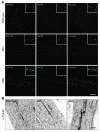Golgi and sarcolemmal neuronal NOS differentially regulate contraction-induced fatigue and vasoconstriction in exercising mouse skeletal muscle
- PMID: 20124730
- PMCID: PMC2827958
- DOI: 10.1172/JCI40736
Golgi and sarcolemmal neuronal NOS differentially regulate contraction-induced fatigue and vasoconstriction in exercising mouse skeletal muscle
Abstract
Signaling via the neuronal NOS (nNOS) splice variant nNOSmu is essential for skeletal muscle health and is commonly reduced in neuromuscular disease. nNOSmu is thought to be the predominant source of NO in skeletal muscle. Here we demonstrate the existence of what we believe to be a novel signaling pathway, mediated by the nNOS splice variant nNOSbeta, localized at the Golgi complex in mouse skeletal muscle cells. In contrast to muscles lacking nNOSmu alone, muscles missing both nNOSmu and nNOSbeta were severely myopathic, exhibiting structural defects in the microtubule cytoskeleton, Golgi complex, and mitochondria. Skeletal muscles lacking both nNOSmu and nNOSbeta were smaller in mass, intrinsically weak, highly susceptible to fatigue, and exhibited marked postexercise weakness. Our data indicate that nNOSbeta is a critical regulator of the structural and functional integrity of skeletal muscle and demonstrate the existence of 2 functionally distinct nNOS microdomains in skeletal muscle, created by the differential targeting of nNOSmu to the sarcolemma and nNOSbeta to the Golgi. We have previously shown that sarcolemmal nNOSmu matches the blood supply to the metabolic demands of active muscle. We now demonstrate that nNOSbeta simultaneously modulates the ability of skeletal muscle to maintain force production during and after exercise. We conclude therefore that nNOS splice variants are critical regulators of skeletal muscle exercise performance.
Figures









Similar articles
-
nNOS splice variants differentially regulate myofilament function but are dispensable for intracellular calcium and force transients in cardiac papillary muscles.PLoS One. 2018 Jul 20;13(7):e0200834. doi: 10.1371/journal.pone.0200834. eCollection 2018. PLoS One. 2018. PMID: 30028847 Free PMC article.
-
Neuronal nitric oxide synthase (nNOS) splice variant function: Insights into nitric oxide signaling from skeletal muscle.Nitric Oxide. 2019 Jan 1;82:35-47. doi: 10.1016/j.niox.2018.11.004. Epub 2018 Nov 29. Nitric Oxide. 2019. PMID: 30503614 Review.
-
Functional deficits in nNOSmu-deficient skeletal muscle: myopathy in nNOS knockout mice.PLoS One. 2008;3(10):e3387. doi: 10.1371/journal.pone.0003387. Epub 2008 Oct 13. PLoS One. 2008. PMID: 18852886 Free PMC article.
-
Sarcolemmal targeting of nNOSμ improves contractile function of mdx muscle.Hum Mol Genet. 2016 Jan 1;25(1):158-66. doi: 10.1093/hmg/ddv466. Epub 2015 Nov 24. Hum Mol Genet. 2016. PMID: 26604149 Free PMC article.
-
nNOS regulation of skeletal muscle fatigue and exercise performance.Biophys Rev. 2011 Dec;3(4):209-217. doi: 10.1007/s12551-011-0060-9. Epub 2011 Nov 8. Biophys Rev. 2011. PMID: 28510048 Free PMC article. Review.
Cited by
-
Effects of neuronal nitric oxide synthase inhibition on microvascular and contractile function in skeletal muscle of aged rats.Am J Physiol Heart Circ Physiol. 2012 Oct 15;303(8):H1076-84. doi: 10.1152/ajpheart.00477.2012. Epub 2012 Aug 24. Am J Physiol Heart Circ Physiol. 2012. PMID: 22923618 Free PMC article.
-
Neuronal nitric oxide synthase mediates insulin- and oxidative stress-induced glucose uptake in skeletal muscle myotubes.Free Radic Biol Med. 2017 Sep;110:261-269. doi: 10.1016/j.freeradbiomed.2017.06.018. Epub 2017 Jun 27. Free Radic Biol Med. 2017. PMID: 28666850 Free PMC article.
-
Becker muscular dystrophy mice showed site-specific decay of type IIa fibers with capillary change in skeletal muscle.Elife. 2025 Mar 17;13:RP100665. doi: 10.7554/eLife.100665. Elife. 2025. PMID: 40094282 Free PMC article.
-
Dystrophin-compromised sarcoglycan-δ-knockout diaphragm requires full wild-type embryonic stem cell reconstitution for correction.J Cell Sci. 2012 Apr 1;125(Pt 7):1807-13. doi: 10.1242/jcs.100537. Epub 2012 Feb 10. J Cell Sci. 2012. PMID: 22328522 Free PMC article.
-
nNOS splice variants differentially regulate myofilament function but are dispensable for intracellular calcium and force transients in cardiac papillary muscles.PLoS One. 2018 Jul 20;13(7):e0200834. doi: 10.1371/journal.pone.0200834. eCollection 2018. PLoS One. 2018. PMID: 30028847 Free PMC article.
References
-
- Stamler JS, Meissner G. Physiology of nitric oxide in skeletal muscle. Physiol Rev. 2001;81(1):209–237. - PubMed
Publication types
MeSH terms
Substances
Grants and funding
LinkOut - more resources
Full Text Sources
Molecular Biology Databases

